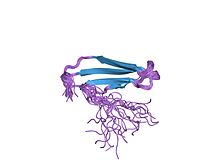WRKY蛋白結構域
WRKY結構域是一類轉錄因子,存在於WRKY轉錄因子家族中[1]。幾乎所有植物基因組中都有帶WRKY結構域的蛋白,同時WRKY基因也被發現存在於雙滴蟲、多細胞變形蟲及其他變形蟲門和一些真菌基因組中。不過WRKY基因似乎不存在於一些其他的非植物物種。在過去的20年間,WRKY轉錄因子一直是植物學領域的重點研究對象[2]。WRKY的DNA識別結構域能夠識別W-box順式作用元件(T)TGAC(C/T),以及W-box序列的一些變體。
| WRKY | |||||||||
|---|---|---|---|---|---|---|---|---|---|
 solution structure of the c-terminal wrky domain of atwrky4 | |||||||||
| 鑑定 | |||||||||
| 標誌 | WRKY | ||||||||
| Pfam | PF03106(舊版) | ||||||||
| Pfam宗系 | CL0274(舊版) | ||||||||
| InterPro | IPR003657 | ||||||||
| |||||||||
結構
編輯WRKY轉錄因子含有一個或兩個WRKY蛋白結構域。 WRKY蛋白結構域是一個長度為60到70個氨基酸的DNA結合結構域。該結構域的主要特徵是一個高度保守的WRKYGQK模序和一個鋅指區域。 半胱氨酸和組氨酸鋅指結構域是CX4-5CX22-23HXH或CX7CX23HXC類型的,其中X可以是任何氨基酸。 [3]鋅指結合Zn2+離子來滿足蛋白質功能的需要。[4]儘管WRKYGQK序列在大多數WRKY結構域中是高度保守的,但是也有文獻記載核心序列是存在差異化的。 [5]核心序列的一種常見的變體是WRKYGKK,存在於大多數植物物種中。[6]
WRKY蛋白結構域的結構由2005年的核磁共振(NMR)和後來的結晶學所確定。[7]WRKY蛋白結構域是由五條反平行β-鏈組成的球形蛋白。核心的WRKYGQK模序位於第二個β鏈上。[8]18個氨基酸在WRKY蛋白結構域中是高度保守的,包括核心基序,鋅指結合的半胱氨酸和組氨酸和形成DWK鹽橋的三聯體。[8]三聯體由位於核心模序的保守色氨酸(W)、四個氨基酸前的天冬氨酸(D)和29個氨基酸後的賴氨酸(K)組成,這個組合穩定了整個結構域。[8]第三個β-鏈上的五個氨基酸(PRSYY)在WRKY結構域中也很保守。[8]重要的是,WRKY基因在WRKY結構域中含有一個保守的內含子,它發生在編碼PRSYY氨基酸序列PR的位置。[3]這就解釋了該基序的保守性。
轉錄因子-DNA相互作用
編輯WRKY結構域形成了一個垂直進入DNA鏈的主溝的獨特楔形結構。 [9]WRKY蛋白結構域與(T / A)TGAC(T / A)順式元件(也稱為W-Box)存在着相互作用。[10]最近的證據表明,W-Box的GAC核心是WRKY結構域的主要作用位點,側翼序列有助於調控DNA與特異性的WRKY蛋白之間的相互作用。[11]核心模序的RKYGQK殘基和WRKY結構域中的精氨酸與賴氨酸殘基負責與七個連續DNA鹼基對(包括GAC核心)的磷酸骨架相互作用。[12]將色氨酸,酪氨酸或WRKYGQK模序的賴氨酸突變為丙氨酸則會使蛋白無法與DNA結合,這個情況表明這些氨基酸對於識別W-Box序列是必不可少的。[13]儘管不是必要的,當用丙氨酸突變掉WRKYGQK模序中的精氨酸,甘氨酸或穀氨酰胺時,可以減少與W-Box的結合。[13]總的來說,WRKY蛋白結構域與DNA的複雜的相互作用會在植物生長發育和抵抗外界脅迫時,起到激活有關基因的作用。
參考文獻
編輯- ^ Rushton, Torres, Parniske, Wernert, Hahlbrock, et al. (1996) Interaction of elicitor-induced DNA-binding proteins with elicitor response elements in the promoters of parsley PR1 genes. The EMBO Journal. 15(20). 5690, Eulgem, Rushton, Robatzek and Somssich (2000) The WRKY superfamily of plant transcription factors. Trends in Plant Science. 5(5). 199-206
- ^ Schluttenhofer and Yuan (2014) Regulation of Specialized Metabolism by WRKY Transcription Factors. Plant Physiology, Bakshi and Oelmüller (2014) WRKY transcription factors: Jack of many trades in plants. Plant Signaling & Behavior. 9(1). e27700
- ^ 3.0 3.1 Eulgem, Rushton, Robatzek and Somssich (2000) The WRKY superfamily of plant transcription factors. Trends in Plant Science. 5(5). 199-206
- ^ Yamasaki, Kigawa, Inoue, Tateno, Yamasaki, et al. (2005) Solution Structure of an Arabidopsis WRKY DNA Binding Domain. The Plant Cell. 17(3). 944-956
- ^ Schluttenhofer and Yuan (2014) Regulation of Specialized Metabolism by WRKY Transcription Factors. Plant Physiology, Zhang and Wang (2005) The WRKY transcription factor superfamily: its origin in eukaryotes and expansion in plants. BMC Evolutionary Biology. 5(1). 1
- ^ Eulgem, Rushton, Robatzek and Somssich (2000) The WRKY superfamily of plant transcription factors. Trends in Plant Science. 5(5). 199-206, Schluttenhofer and Yuan (2014) Regulation of Specialized Metabolism by WRKY Transcription Factors. Plant Physiology, Zhang and Wang (2005) The WRKY transcription factor superfamily: its origin in eukaryotes and expansion in plants. BMC Evolutionary Biology. 5(1). 1, Song, Wang, Nan and Wang (2014) The WRKY Transcription Factor Genes in Lotus japonicus. International Journal of Genomics. 2014(15, Xiong, Xu, Zhang, Wu, Chen, et al. (2013) Genome-wide analysis of the WRKY gene family in physic nut (Jatropha curcas L.). Gene. 524(2). 124-132
- ^ Yamasaki, Kigawa, Inoue, Tateno, Yamasaki, et al. (2005) Solution Structure of an Arabidopsis WRKY DNA Binding Domain. The Plant Cell. 17(3). 944-956, Duan, Nan, Liang, Mao, Lu, et al. (2007) DNA binding mechanism revealed by high resolution crystal structure of Arabidopsis thaliana WRKY1 protein. Nucleic Acids Research. 35(4). 1145-1154
- ^ 8.0 8.1 8.2 8.3 Duan, Nan, Liang, Mao, Lu, et al. (2007) DNA binding mechanism revealed by high resolution crystal structure of Arabidopsis thaliana WRKY1 protein. Nucleic Acids Research. 35(4). 1145-1154
- ^ Yamasaki, Kigawa, Watanabe, Inoue, Yamasaki, et al. (2012) Structural Basis for Sequence-specific DNA Recognition by an Arabidopsis WRKY Transcription Factor. Journal of Biological Chemistry. 287(10). 7683-7691
- ^ Rushton, Torres, Parniske, Wernert, Hahlbrock, et al. (1996) Interaction of elicitor-induced DNA-binding proteins with elicitor response elements in the promoters of parsley PR1 genes. The EMBO Journal. 15(20). 5690, Eulgem, Rushton, Schmelzer, Hahlbrock and Somssich (1999) Early nuclear events in plant defence signalling: rapid gene activation by WRKY transcription factors. EMBO J. 18(17). 4689-4699, De Pater, Greco, Pham, Memelink and Kijne (1996) Characterization of a Zinc-Dependent Transcriptional Activator from Arabidopsis. Nucleic Acids Research. 24(23). 4624-4631
- ^ Brand, Fischer, Harter, Kohlbacher and Wanke (2013) Elucidating the evolutionary conserved DNA-binding specificities of WRKY transcription factors by molecular dynamics and in vitro binding assays. Nucleic Acids Research. 41(21). 9764-9778
- ^ Yamasaki, Kigawa, Watanabe, Inoue, Yamasaki, et al. (2012) Structural Basis for Sequence-specific DNA Recognition by an Arabidopsis WRKY Transcription Factor. Journal of Biological Chemistry. 287(10). 7683-7691, Brand, Fischer, Harter, Kohlbacher and Wanke (2013) Elucidating the evolutionary conserved DNA-binding specificities of WRKY transcription factors by molecular dynamics and in vitro binding assays. Nucleic Acids Research. 41(21). 9764-9778
- ^ 13.0 13.1 Duan, Nan, Liang, Mao, Lu, et al. (2007) DNA binding mechanism revealed by high resolution crystal structure of Arabidopsis thaliana WRKY1 protein. Nucleic Acids Research. 35(4). 1145-1154, Maeo, Hayashi, Kojima-Suzuki, Morikami and Nakamura (2001) Role of conserved residues of the WRKY domain in the DNA-binding of tobacco WRKY family proteins. Bioscience, Biotechnology, and Biochemistry. 65(11). 2428-2436